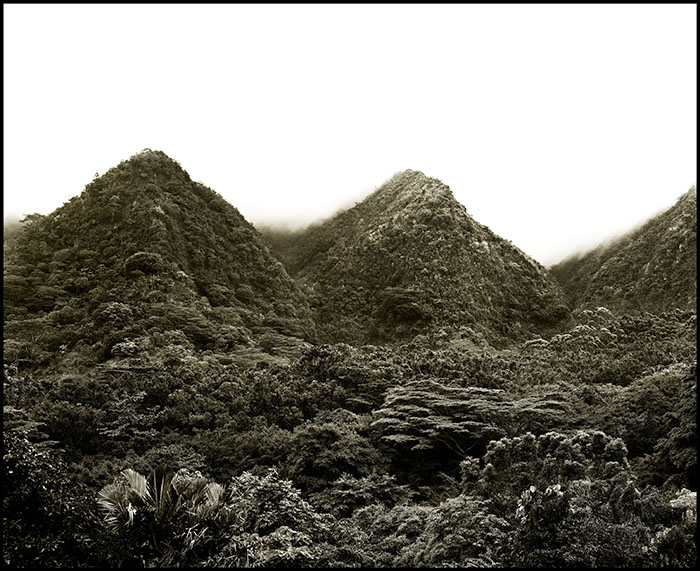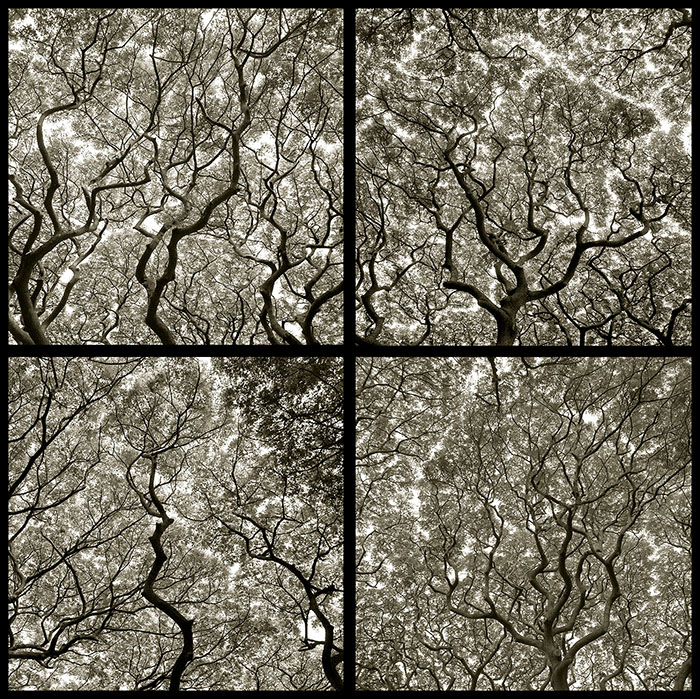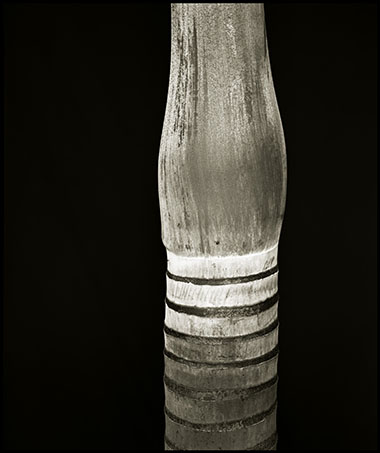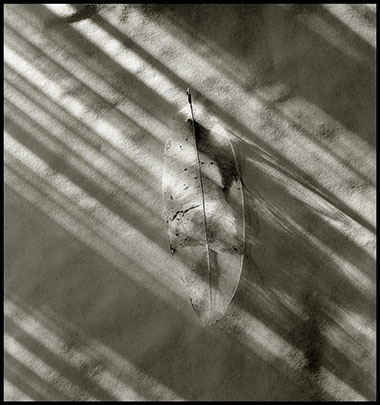Rainforest: Oahu, Hawaii, 1991
On the last day of the world
I would want to plant a tree
—W.S. Merwin
In the forest above Manoa Valley and upward through the hills on the island of Oahu it's raining. The salmon crested cockatoos call and cry to each other. The earth is moist and the ground holds its melting leaves. What does intricacy have to say about shades of green, trees that are fully awake, the earnestness of insects or the language of the zebra doves? Every look is a bloom of midnight colors. Every inch of ground has an expression. Rain is as present as the slow reach of shadows. How long did it take to create this dark forest of so many living things? The difference between a desert and a rainforest must be water.
William Merwin, former U.S. Poet Laureate and twice awarded the Pulitzer Prize, died in March 2019. William and his wife Paula turned their 19 acres in Maui, Hawaii, into a lush palm garden. Over 40 years, they planted more than 3,000 trees, including nearly 900 different varieties of indigenous and endangered palms. Today, it is considered one of the most important collections of palms in the world. My wife Naomi was close friends with Paula and William, and served on the board of the Merwin Conservancy.
It was July of 1991 when William was asked to speak on the impact on earth's changing climate in Honolulu. We were living in Honolulu for six months, Naomi teaching at the University of Hawaii and I practicing law long distance. The event director somehow failed to promote William's lecture. The auditorium was mostly empty. Eleven individuals were present. William spoke for one hour and fifteen minutes. Passionately. Without notes. His poems and stories connected us to our planet, and to responsibility. At dinner that night, after his lecture, we talked about palm trees and the generosity of dirt. He never mentioned the mostly empty auditorium.
The next morning, William took Naomi and me for a hike and a look. We drove above Honolulu, above Manoa valley into a cloudy lush rainforest. We hiked up among the thick trees. We stood still for a long time. William knew the history of trees, birds and the sounds they made. He picked up fallen leaves. William stopped and pointed to a tall palm that rose upward into the canopy. Our heads lifted. William told us, "This palm, Spectabilis, is extremely rare. Endangered. It has a remarkable life cycle. It lives to 100 years, blooms only once, branches into hundreds of tiny flowers and dies. Spectabilis means 'blessed.'"
Sometimes, what you don't want to do becomes the thing you want to do the most. I never really wanted to live in Hawaii. I thought it might be confining. However, the first week in our apartment high on the hills overlooking the lights of Honolulu and the Pacific Ocean, the trade winds that traveled so far rocked us to sleep. An island has a gravity and pull that it owns.
Rain Forest Series—Lyon Arboretum
From 26 Series of Essays & Photographs
Series #16: Rainforest, Oahu Hawaii
Photographs 1991, Essay 2021

Harold Lyon Arboretum is a 200-acre botanical garden and tropical rainforest with a collection of more than 5,000 plant species. For four months, a few days each week I spent time hiking and photographing in Lyon Arboretum. I would pack a lunch and hike up into the rainforest hills.
At night in Hawaii, loading my 8" x 10" negatives into my film holders, I wondered what light will touch this film. This series of photographs was the result and a desire to spend time in a rainforest. I photographed tree trunks—bodies of trees, younger and older tree trunks in the same way I would photograph people. I also looked upward and made photographs of the forest canopy.
There were challenges. My equipment was heavy and awkward. I brought in my 8" x 10" view camera, tripod, film plates and backdrop. It rained. I used large plastic sheets to protect my film and camera. It was muddy and slippery climbing up and down hills and valleys. My camera fell over. I fell over. My backdrop blew and tumbled. Many of the sheet films were ruined by moisture. I wondered what I was doing? Large branches, foliage, steep slopes, other trees prevented mobility. Why was I making this simple series of photographs so difficult? Why was I photographing trunks of trees?
Three birdwatchers in Lyon Arboretum pointed their fingers toward a flying red-vented bulbul. The forest of trees leans in the late afternoons. The muted light and rain impacts mood. At night, the moonlight, the starlight, and rain fall on leaves before finding the soil. Many days I would not photograph at all, but just listen. The sounds in this deep place were active. The leaves, the wind, the rain, the birds, the murmuring, the distant moan, the chirping behind me, the hum high in the trees, moving water, the insects were all using this space at the same time.

The birds and ants know how lucky they are living on this island. The rain arrives each early afternoon on time. Our attention changed while we were living on Oahu. What became important, what we talked about, what we thought about privately were sensory experiences. The richness of the soft air, Hawaiian words and songs, the ocean and its sand, the rainforest and its community of greenness seeped into our bones.
Last Notes
In August 2016 I interviewed and photographed William Merwin in his home on the island of Maui, Hawaii. I was working on project on blindness and adaptation. I heard that William was losing his eyesight due to macular degeneration. I flew to Maui and spent the afternoon asking William questions about the nature of perception. William and Paula were living in the middle of their 40-year-old palm forest. William wanted to talk about his palm garden. "Trees are our teachers. They are millions and millions of years old and connect us to the earth and being alive. We know so little about trees. We have to pay attention."
February 2021

Michael Nye practiced law for ten years before pursuing photography full time. He has received a Mid-America National Endowment for the Arts grant in photography and two Kronkosky Charitable Foundation grants, and a Warren Skaaren Charitable Trust Grant. His journeys to photograph include projects in Russian Siberia, Iraq during the first Gulf War, Palestine, China, and Labrador. He has participated in two Arts America tours in the Middle East and Asia. His documentaries, photography & audio exhibitions, Children of Children, Fine Line: Mental Health/Mental Illness and About Hunger & Resilience have traveled to more than 150 cities across the country. His new exhibition, My Heart Is Not Blind debuted at the Witte Museum in 2019. (Trinity University Press released a book, My Heart Is Not Blind, with extended text and photographs.) Nye lives in downtown San Antonio and married to poet Naomi Shihab Nye.










